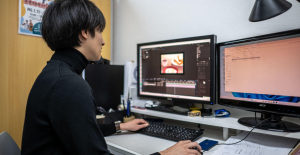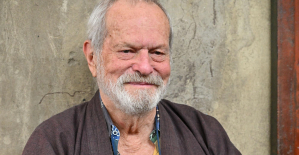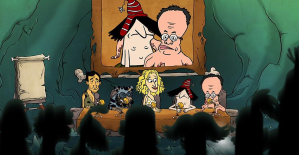When it comes to Amsterdam, most people rightly think of romantic waterways and bridges, narrow canal houses, countless bicycles, a colorful red-light district, the smell of French fries and hashish in the air. The Dutch city also has a lot to offer in terms of art and history.
In the Museumsplein you will find the well-known Rijksmuseum, the Van Gogh Museum, within walking distance the Hermitage and Stedelijk Museum, the Anne Frank or Rembrandt house. Over 70 museums await visitors, including some smaller ones that can be quite unusual. We took a closer look at six of them.
The narrower the streets, the stronger the smell of marijuana. He accompanies you almost every step of the way in Amsterdam. Cannabis, Space Cakes. Most of the approximately 20 million annual visitors are drawn to one of the 150 or so coffee shops where smoking weed is legal.
Amsterdam's mayor would like to ban tourists from entering to curb the growing party tourism. But Amsterdam is proud of its hashish culture, so in addition to a cannabis college, there is also hash marijuana
Learn about the cultivation, purity, and medicinal uses of marijuana. The museum is housed in a canal house and features rare artefacts.
Ben Dronkers collected most of the approximately 9,000 objects. When he opened the museum in 1987, the Dutch Minister of Justice tried in vain to have it closed again. The Minister for Public Welfare, Health and Culture attended the reopening after extensive restoration in 2012 – how times have changed!
A separate department in the museum is now dedicated to the German photographer Maren Kriegs, who visited more than 200 hemp projects in 26 countries for six years. She spoke to more than 80 experts there and took impressive pictures. Tip: There is a photo box just before the exit. You can take a picture of yourself in a huge hemp field. Hilarious.
Infos: Hash Marihuana
It couldn't be more magical. Enjoyment and relaxation are at home in the basement of a canal house. The pipe museum adjoins a small shop - a catwalk of pipes, one presented there more beautifully than the other.
For many, the pipe is a reflection of society, whether it is a tobacco, opium or hookah pipe. They all deal with rituals and traditions. You can find out everything about it here for over 50 years. The museum used to be called the Pijpenkabinet, and it shows wonderful pipes made of different materials and with crazy motifs.
A paradise for avid pipe smokers and Don Duco is a great host. The curator can also explain a few things to self-appointed experts. Talk to him, he's happy about it. Duco has turned a hobby into a passion and has collected pieces that cannot be admired anywhere else. Like the oldest whistle in the world from 550 BC. or an ivory pipe from the Chinese opium culture.
In 2020 he received the European Cultural Heritage Prize for this. During the pandemic, the museum had no income from visitors for more than a year and a half. Duco was forced to add a corona surcharge to the entrance fee.
Info: Amsterdam Pipe Museum, Prinsengracht 488, open Mon-Sat 12pm-6pm, admission 12.50 euros, pipemuseum.nl
Life on the water, called "waterwoning", has a long tradition in Holland. There are around 10,000 houseboats in the country, 2,500 of them in Amsterdam alone. The advantage of a houseboat: It is classified as a sports boat, so you do not need a building permit.
All important connections exist at the berths, and so the possibilities of houseboats today hardly differ from normal apartments. In the meantime, Amsterdam does not allow any more berths, the waters are almost fully booked, which is causing the prices of existing boats to explode. There is currently only one houseboat for sale – for 600,000 euros.
Vincent van Loon lived on a houseboat for a long time, in 1997 he turned it into a museum and moved into a "normal" apartment. Its berth is not far from the famous Anne Frank House.
His "Hendrika Maria" is a former cargo ship from 1914 measuring 23 x 4.5 meters. From the cargo hold he built a bedroom and living room, a kitchen, a toilet and two more bedrooms, a total of 80 square meters of living space, the furniture dates from the 1990s or is even older. He describes it as comfortable. That is certainly a matter of opinion.
On deck, van Loon tends his garden with lots of flowers and a small terrace. Vincent van Loon takes a lot of time for questions from his visitors.
Info: Houseboat Museum, Prinsengracht 296 K, 10am-5pm (closed on Mondays), admission 4.50 euros, houseboatmuseum.nl
It is the theater of executions. Whoever enters gets to know the painful world of torture and death. The executioner lives very close to the famous Bloemenmarkt in Amsterdam. What's missing: the screams of death on the torture bench and howling crowds around the shame block.
But even without the original background noise, the Torture Museum illustrates the barbaric conditions in the Middle Ages. Those accused of heresy faced cruel penalties, and peace was not found even in death, at least not on the way there, because it was paved with unimaginable torments.
Illustrations show how the torture devices on display were used. Such as the "Schandflöte", an iron flute that was attached to the neck with an iron ring and trapped the playing fingers. No joke: Those who didn't play properly got it.
Significantly more brutal: the inquisition chair, which has small spikes on the seat, armrests and backrest. During the interrogation, the tormented woman (suspected as a witch) recalled bizarre encounters with the devil. She was then fixed on a red-hot grate and sprinkled with cold water, a combination of cleansing and purifying powers intended to save the sinner's soul.
At the end of the tour, which leads over several floors, there is a guillotine and next to it a notice board stating that torture is still used today, that the death penalty still exists in some countries, and the question is asked: would the audience today really so different from the crowds that used to cheer the executioner?
Information: Torture Museum, Singel 449, open daily from 10 a.m. to 11 p.m., admission 9.50 euros, torturemuseum.org
A must for Amsterdam visitors, especially the younger ones. The chic Villa Alsberg right on the Museumsplein has been home to modern and contemporary art since 2016.
Right behind the entrance, around 50 works by the cool Brit Banksy await you, a pseudonym because the street artist has been successfully keeping his real name and true identity secret for years. His most popular image is of a girl releasing a heart-shaped balloon.
In addition to Banksy, a top-class digital art is offered. TeamLab Tokyo is a collective of programmers, engineers, CG animators, mathematicians and and and. It plays with laser beams, colored lights and electronic sounds and offers the visitor brightly colored selfie opportunities. Also admire: Keith Haring, Andy Warhol, Damien Hirst, Jeff Koons, Mark Rothko, artists who inspired the next generation.
The fact is: even if you are not an art lover, you will get your money's worth here. Already by the interesting Japanese artist Yayoi Kusama, she has designed rooms spectacularly with lights, such as the "Starry Night" (great selfie motif).
Info: Moco Museum, Honthorststraat 20, open daily 8.30am-9pm, admission 15.95 euros, mocomuseum.com
Only opened in April and therefore not yet found in any travel guide, this digital art museum is an absolute Amsterdam highlight. The "Fabrique des Lumières" can be reached by bus in a few stops from the main train station in the still new cultural center of Westergas, which combines theatre, art and gastronomy.
The "Zuiveringshal West" has an area of 2800 square meters and a ceiling height of 17 meters. Ideal for the colorful art projections by Gustav Klimt and Hundertwasser. With classical music, the images alternate in front of, below and next to you. Wherever you are, you are right in the middle of it, even with Klimt's famous "Kiss".
The two studios “Journey” and “Memories” are exceptions. Here visitors lie on the floor, the works of art are reflected everywhere and you experience an incredible spectacle. Even two small chambers for souvenir selfies at the very end of the hall were thought of.
Info: Fabrique des Lumières, Pazzanistraat 37, open daily from 9 a.m. to 5 p.m. (until 9 p.m. on Saturdays), admission 15 euros, fabrique-lumieres.com

 United States: divided on the question of presidential immunity, the Supreme Court offers respite to Trump
United States: divided on the question of presidential immunity, the Supreme Court offers respite to Trump Maurizio Molinari: “the Scurati affair, a European injury”
Maurizio Molinari: “the Scurati affair, a European injury” Hamas-Israel war: US begins construction of pier in Gaza
Hamas-Israel war: US begins construction of pier in Gaza Israel prepares to attack Rafah
Israel prepares to attack Rafah First three cases of “native” cholera confirmed in Mayotte
First three cases of “native” cholera confirmed in Mayotte Meningitis: compulsory vaccination for babies will be extended in 2025
Meningitis: compulsory vaccination for babies will be extended in 2025 Spain is the country in the European Union with the most overqualified workers for their jobs
Spain is the country in the European Union with the most overqualified workers for their jobs Parvovirus alert, the “fifth disease” of children which has already caused the death of five babies in 2024
Parvovirus alert, the “fifth disease” of children which has already caused the death of five babies in 2024 Falling wings of the Moulin Rouge: who will pay for the repairs?
Falling wings of the Moulin Rouge: who will pay for the repairs? “You don’t sell a company like that”: Roland Lescure “annoyed” by the prospect of a sale of Biogaran
“You don’t sell a company like that”: Roland Lescure “annoyed” by the prospect of a sale of Biogaran Insults, threats of suicide, violence... Attacks by France Travail agents will continue to soar in 2023
Insults, threats of suicide, violence... Attacks by France Travail agents will continue to soar in 2023 TotalEnergies boss plans primary listing in New York
TotalEnergies boss plans primary listing in New York La Pléiade arrives... in Pléiade
La Pléiade arrives... in Pléiade In Japan, an animation studio bets on its creators suffering from autism spectrum disorders
In Japan, an animation studio bets on its creators suffering from autism spectrum disorders Terry Gilliam, hero of the Annecy Festival, with Vice-Versa 2 and Garfield
Terry Gilliam, hero of the Annecy Festival, with Vice-Versa 2 and Garfield François Hollande, Stéphane Bern and Amélie Nothomb, heroes of one evening on the beach of the Cannes Film Festival
François Hollande, Stéphane Bern and Amélie Nothomb, heroes of one evening on the beach of the Cannes Film Festival Skoda Kodiaq 2024: a 'beast' plug-in hybrid SUV
Skoda Kodiaq 2024: a 'beast' plug-in hybrid SUV Tesla launches a new Model Y with 600 km of autonomy at a "more accessible price"
Tesla launches a new Model Y with 600 km of autonomy at a "more accessible price" The 10 best-selling cars in March 2024 in Spain: sales fall due to Easter
The 10 best-selling cars in March 2024 in Spain: sales fall due to Easter A private jet company buys more than 100 flying cars
A private jet company buys more than 100 flying cars This is how housing prices have changed in Spain in the last decade
This is how housing prices have changed in Spain in the last decade The home mortgage firm drops 10% in January and interest soars to 3.46%
The home mortgage firm drops 10% in January and interest soars to 3.46% The jewel of the Rocío de Nagüeles urbanization: a dream villa in Marbella
The jewel of the Rocío de Nagüeles urbanization: a dream villa in Marbella Rental prices grow by 7.3% in February: where does it go up and where does it go down?
Rental prices grow by 7.3% in February: where does it go up and where does it go down? Even on a mission for NATO, the Charles-de-Gaulle remains under French control, Lecornu responds to Mélenchon
Even on a mission for NATO, the Charles-de-Gaulle remains under French control, Lecornu responds to Mélenchon “Deadly Europe”, “economic decline”, immigration… What to remember from Emmanuel Macron’s speech at the Sorbonne
“Deadly Europe”, “economic decline”, immigration… What to remember from Emmanuel Macron’s speech at the Sorbonne Sale of Biogaran: The Republicans write to Emmanuel Macron
Sale of Biogaran: The Republicans write to Emmanuel Macron Europeans: “All those who claim that we don’t need Europe are liars”, criticizes Bayrou
Europeans: “All those who claim that we don’t need Europe are liars”, criticizes Bayrou These French cities that will boycott the World Cup in Qatar
These French cities that will boycott the World Cup in Qatar Medicine, family of athletes, New Zealand…, discovering Manae Feleu, the captain of the Bleues
Medicine, family of athletes, New Zealand…, discovering Manae Feleu, the captain of the Bleues Football: OM wants to extend Leonardo Balerdi
Football: OM wants to extend Leonardo Balerdi Six Nations F: France-England shatters the attendance record for women’s rugby in France
Six Nations F: France-England shatters the attendance record for women’s rugby in France Judo: eliminated in the 2nd round of the European Championships, Alpha Djalo in full doubt
Judo: eliminated in the 2nd round of the European Championships, Alpha Djalo in full doubt


















